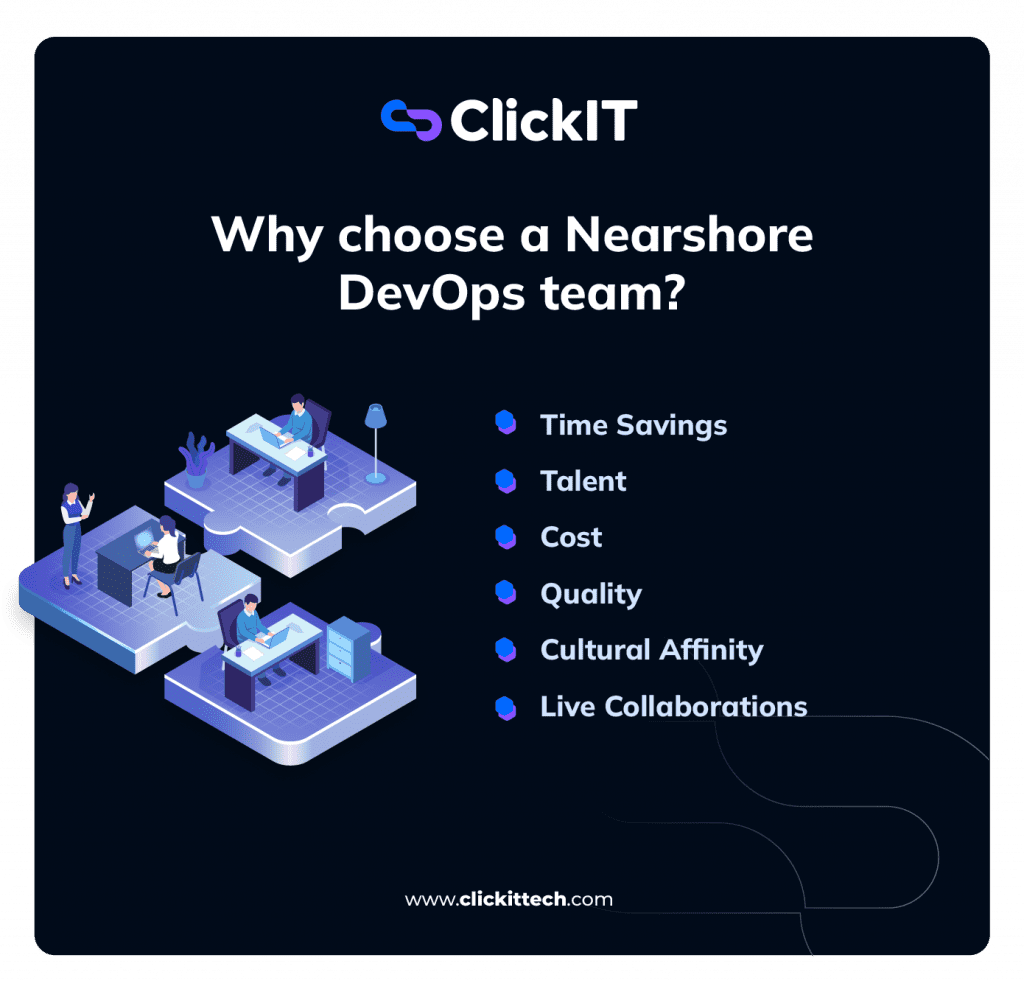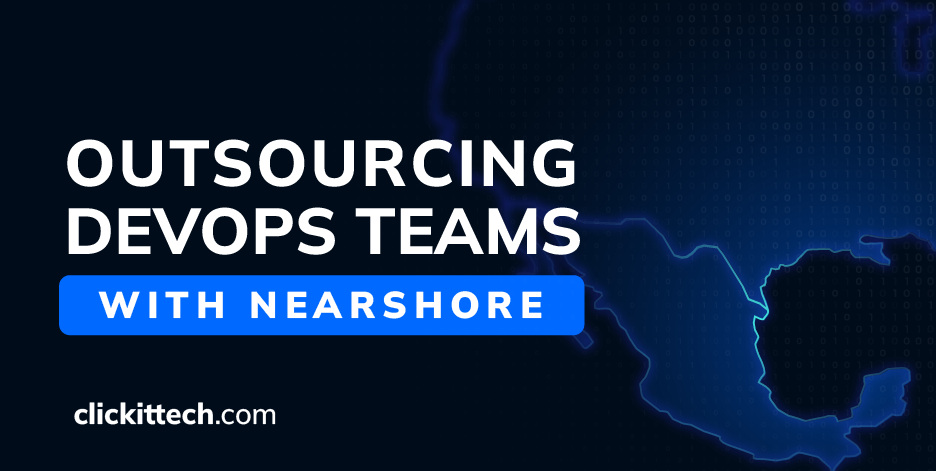Are you tired of ongoing scrum meetings in the evening with your offshore team? Are you stressed about collaborating on something urgent and getting results until the next day due to the time zone differences? If that’s you, I have your solution to save time developing with a Nearshore DevOps Outsourcing team.
- What is Nearshore DevOps Outsourcing?
- How does Nearshore DevOps Outsourcing affect your work lifestyle?
- Why choose a Nearshore DevOps team?
- Difference between Outsourcing DevOps and Nearshore DevOps
- Conclusion of Nearshore DevOps Outsourcing
What is Nearshore DevOps Outsourcing?
There are different ways to hire a DevOps team. It can be offshore, nearshore, or onshore, depending on your needs. If you’re thinking, “DevOps is too hard to find it locally, and even more in my area,” or “Is it possible to find DevOps at a low cost with exceptional quality? (compared to U.S DevOps Agencies). Let me tell you that nearshore outsourcing is what you have been looking for without noticing it!
How does Nearshore DevOps Outsourcing affect your work lifestyle?
You can reduce costs by outsourcing DevOps and sending your IT Team to Asia or Eastern Europe. But do you really need to sacrifice your lifestyle to work at night or at daybreak?
During my career, I’ve collaborated with over 100 IT teams around the globe, 70% offshore. Some of them as Lead DevOps, software architect, and cloud director. That being said, the collaboration between the offshore team and the customer is exhausting with the passing of weeks.
I’ve been there, and it’s just a nightmare. I have worked with dozens of web development agencies offshore, and it can be really exhausting for everyone: customers, the offshore team, and us as DevOps. This means having scrum meetings, reproducing an error with screen-sharing, showing a demo, and having video calls at unwanted hours. Working with a team in different time zones comes with its own difficulties.
Another good example is when there is an emergency in the middle of the business day. Imagine that your AWS cloud application is down due to last night’s code deployment. Because of this, you have to wait for around 6-10 hrs for the offshore team to fix or respond to revert those changes. With a financial service, e-commerce, or media firm, how much money are you willing to lose during these downtimes? This kind of problem may happen occasionally, but it’s a risk you won’t want to take on a daily basis.

Why choose a Nearshore DevOps team?
By choosing the nearshore model, you can partner with a skilled DevOps team and work with their agile customer-value-driven approach. While enjoying the benefits of optimizing costs and increasing productivity through outsourcing to a nearby country.
- Time Savings
Working with a Nearshore model enables you to save time and money while collaborating on the same day and time zone. And, when necessary, quick travels to the US or Canada are more achievable. You can move to any U.S. city within a few hours and meet face-to-face for critical updates, new releases, or a new project launch. The adoption of this practice will help you save lots of hours per day, have a better quality of life at work, and deliver your product faster than ever before. - Talent
Latin America, and specifically Mexico, has very high-quality talent in computer science and software development. They can help you decide to nearshore with a DevOps Mexican company and improve your development productivity.
Mexico counts with recognized universities that compete with the highest universities in U.S., Canada, Europe, and Australia. Additionally, we know that Mexico is in the top 10 emerging market economies due to its effort to improve its workforce.
Hire our nearshore staff augmentation services to add tech experts to your team!
- Cost
IT Development Costs in Mexico are very similar to Asia, India, and Eastern Europe. Saving you the time to investigate these markets, we have some hourly rate facts according to “The Accelerance – The Global Software Outsourcing Authority”. Asia oscillates around 15-35 USD/hr. Eastern Europe, approximately 25-50 USD/hr, and Mexico/Latin America, around $20-$45 USD/hr.
On the other hand, If we compare an American, a Canadian, or an Australian engineer, the hourly rate ranges between 70-265 USD/hr – so Mexico is not cheaper than India or Asia. Still, it is not as expensive as in Eastern Europe. As a final thought, these hourly rates cover the TCE (Total Cost of Engagement), which are taxes, contracting costs, onboarding processes, bonuses, and health and life insurance. The analysis of the indicated rates, the result of oriented engineers, the cutting-edge expertise, and the real-time collaboration enable Mexico to be the first choice. Overall, the TCE as a nearshore is 3-5x more affordable than a local engagement.
Working with a Nearshore DevOps team matters so much and means more benefits for your company. Read our blog Nearshore Software Development Company: Essential Characteristics to know more about this model. - Quality
What makes a good engineer deliver high quality? To name a few key considerations: Attention to detail, proactively taking tasks on their own initiative, delivering web products with no bugs, adopting best practices, and implementing cutting-edge technologies. Given these qualities and considering that Mexico is in the Top 10 Automotive and Manufacturing Industries, you can be sure that Mexico provides world-class quality in DevOps and web development. - Cultural Affinity
It is about the easiness of doing business with Mexico and Latin America. If you’re asking yourself, “Does cultural affinity matters in collaboration? Is this one of the top qualities of a startup’s culture and mission? Let me tell you that the answer is yes. Surely! Cultural affinity matters in any business. The shared values and positive mindset you’ll find in Latin American teams will surely surprise you and lead to greater results in your project.
Did you know that Latin America has the highest country rankings on happiness? - Live Collaborations
As we reviewed, compared to offshoring, nearshore also allows savings costs. Due to involving shorter trips and the advantages that the TN Visa and NAFTA provide for Nearshore DevOps teams. In a few hours, you can have your face-to-face meeting with your team and multitask your new IT project with your peers as in any other U.S. Headquarter office. I have clients worldwide, so my team travels every 3 months to review an initial/final sprint. This is very healthy for the engineers, taking them out of their usual routine and engaging more with the customer thanks to Nearshore collaboration.
If you want to learn about remote collaboration, please read our blog, Remote Collaboration: A Complete Guide 2022 Edition.

Difference between Outsourcing DevOps and Nearshore DevOps
Some people ask what’s the difference between the concepts of “Outsourcing DevOps” and “Nearshore DevOps.” The truth is that there is no point in comparing them since they are complementary concepts.
Outsourcing DevOps is the primary term and is segmented into three categories or ways to outsource your workloads.
They are onshore, offshore, and nearshore. You can compare them to see what fits the best for your organization’s needs. In my experience, if you are looking to outsource your IT services (Outsourcing DevOps), I would advise you to think of the Nearshore model as your first option.
Conclusion of Nearshore DevOps
We can assume that adopting outsourcing DevOps with a Nearshore model can have more benefits than typical Outsourcing (Off-shore). Since you are not extending your team to another continent (as you have to do in offshore models), which can produce what I call a “Jet Lag” in your team collaboration.
DevOps culture is a relatively new practice in enterprises and digital startups. Building a new Nearshore DevOps team is taking a step towards IT modernization and Digital Transformation.
That’s why engaging a nearshore model with ClickIT enables companies to improve development productivity and product deliverables by attending urgent tasks on the same day, having daily scrum meetings with the whole team, and quickly resolving back-and-forth tasks due to online collaboration on most of the business day.
Now you have discovered, as a Product Owner, Startup founder, or Engineer Director, that offshoring is not the only option to save costs. Take into consideration that offshore can have its downsides because of the multiple differences between the teams. After this, you now know how it is to work with a Nearshore DevOps team and how productive your IT partners can be with this type of engagement. Give it a try! It could be one of your best decisions.
ClickIT DevOps and Software Development is a vibrant digital company that loves to innovate and build native cloud applications. We’re passionate to collaborate with customers following our company culture and values.

FAQ
A DevOps Team is a multidisciplinary team of specialists working all together on iterations to provide instantaneous feedback and avoid delays and extra costs on the infrastructure and development. DevOps are the gurus of cloud services and Linux; with their expertise, they can help you improve and grow your business.
Outsourcing is the process of engaging a non-affiliated third party to execute certain IT activities for a firm. Outsourcing IT employs an outside organization’s established personnel to accomplish activities and an external organization’s resources for services and producing products.
Nearshore, offshore, and onshore are the top outsourcing models.
– Onshore: Outsourcing services with a team located in the same country whose headquarters or business operations are usually in a different city.
– Nearshore: Outsourcing services to a company in a different country but sharing similar time zones and cultural affinity. It is a more cost-effective solution than other types of outsourcing, and it ensures the same level of expertise as in-house teams.
– Offshore: When a company outsources projects to a company in a different country, with an opposite time zone.
The Nearshore Outsourcing model gives you access to a wide talent pool and reduced costs, just as all three outsourcing models do. But with nearshore, you have extra benefits, like cultural affinity, similar time zones, and an excellent communication strategy with no delays.








